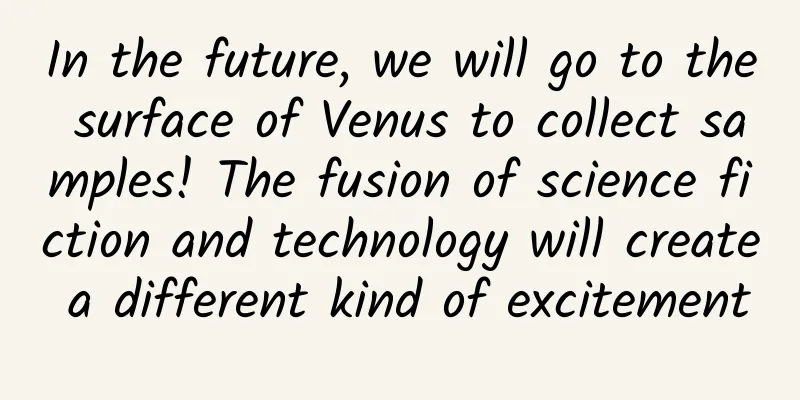In the future, we will go to the surface of Venus to collect samples! The fusion of science fiction and technology will create a different kind of excitement

|
Imagine a day in the future. Astronauts wearing custom-made space suits walk on Mars, breathing oxygen generated by the Martian atmosphere. Inflatable aircraft shaped like birds fly in the sky of Venus, detecting the atmospheric composition and weather patterns of Venus... This is like a plot from a science fiction work, but this scenario may come true in the near future. In February 2022, NASA released the selection results of this year's innovative advanced concept program on its official website, with a total of 18 projects selected. This article selects 9 innovative solutions closely related to the field of deep space exploration for a brief description, involving asteroid defense, in-situ resource utilization, life support, sample return, autonomous probes, etc., hoping to bring some inspiration to everyone. Human Terminal Defense System It is reported that an asteroid with a diameter greater than 1 km will cause a huge explosion and trigger a tsunami after hitting the earth, and humans will face the threat of extinction. 65 million years ago, an asteroid with a diameter of 10 km hit the coast of the Yucatan Peninsula in Mexico, which caused the extinction of nearly 75% of species on the earth, including dinosaurs. In 1908 and 2013, meteorite explosions occurred in Tunguska and Chelyabinsk in Siberia, Russia, respectively, destroying 80 million trees and injuring more than 1,000 people. In response to the possible hazards caused by asteroids, countries around the world have conducted relevant research and proposed a series of active defense plans. At present, there are three main ways of active defense against asteroids: one is to change the orbit of asteroids by kinetic impact, such as the United States' deep space impact program and the Double Asteroid Redirection Test Program (DART); one is to use long-term forces to change the orbit of asteroids, such as space tugs; and the other is to use nuclear explosions. Philip Rubin of the University of California proposed a planetary defense solution based on existing technology. By deploying a series of small hypervelocity kinetic penetrators in space, it can crush and decompose asteroids or comets, thereby protecting the earth from asteroids. This solution can effectively defend against asteroids with a diameter of hundreds of meters, but its defense effect mainly depends on the time required to intercept the asteroid and the size of the asteroid. Scientists estimate that the human terminal defense system only needs 5 hours before the impact to destroy an asteroid of the same size in the Tunguska event (50 meters in diameter and an explosion of about 1,000 megatons). Larger targets such as large planets such as Apophis (370 meters in diameter) can also be intercepted 10 days before the impact. If the system is deployed in orbit or on a lunar base in advance, the response time of the system will be shorter. Schematic diagram of asteroid defense plan Active asteroid defense is an effective means for humans to deal with planetary and comet impacts. It also enables humans to truly have the autonomous ability to deal with asteroid threats for the first time. Venus Atmosphere/Cloud Particle Sample Return MIT astronomers have proposed a new spacecraft design for a sample-return mission to Venus to assess the habitability of the cloud regions of the planet's atmosphere and search for signs of life. For decades, Venus has been speculated to be a habitable planet based on its temperate clouds. Despite the extremely low water content and the presence of concentrated sulfuric acid in Venus' clouds, long-unexplained atmospheric measurements and new discoveries support the idea that Venus may have microbial life, but astrobiological research is not the focus of this project. The flight system in this program consists of an orbital probe and an orbiter. The orbital probe consists of a variable-altitude balloon that works at an altitude of 45 to 60 kilometers. The balloon's gondola contains sampling equipment and an ascent vehicle. After completing sampling from different locations in the atmosphere, the aerial platform will rise to an altitude of about 70 kilometers, the ascent vehicle will start and rendezvous with the orbiter, and then the sampling will be returned. This program supports NASA's goal of expanding human cognition through new scientific discoveries and its mission of "promoting progress in science, technology, and space exploration to expand human cognition." Schematic diagram of Venus sample return plan "Customized" Mars exploration space suit Extravehicular space suits can be thought of as humanoid "spacecrafts" that protect astronauts from the harsh environment of outer space and provide a microenvironment for astronauts to survive. However, due to various reasons, not all space suits can play their role, and many crew members have experienced shoulder injuries, nail loss and other problems. Therefore, customized space suits have become an effective way to solve the problems faced by different crew members. But how can this be done quickly and effectively? Researchers from Texas A&M University have given the answer. They are studying the feasibility of manufacturing low-cost, high-performance customized space suits for Mars exploration. Through digital human body scanning, digital design/analysis, and robotic manufacturing, a digital model is finally formed to provide a basis for the development of future space suits. Schematic diagram of Mars exploration space suit The project aims to solve several major problems facing deep space exploration: 1. The ability to quickly design and manufacture space suits for extravehicular activities based on the individual differences of different astronauts; 2. The ability to establish a digital twin system and continuously optimize and improve space suit design based on experience and lessons learned; 3. Deep space explorers can manufacture or repair certain extravehicular space suit components in situ based on digital files; 4. Incorporate the digitization of space suits into the entire Mars mission architecture and operation plan, including resupply, in situ repair and manufacturing, and reuse of raw materials. Mars Fixed, Portable Oxygen Concentrator One of the key challenges of human Mars missions is the in-situ resource utilization (ISRU) technology to solve the problem of long-term Mars exploration without immediate supply. In particular, oxygen is both a propellant for the Mars Ascent Vehicle (MAV) and a necessary resource for sustaining life. The oxygen generator proposed by Arizona State University mainly uses the so-called temperature swing adsorption/desorption (TSSD) process to produce oxygen using the Martian atmosphere as a raw material. Compared with existing technologies, the same amount of oxygen can be produced with 10 times less energy consumption. How Portable Oxygen Concentrators Work In April 2021, NASA conducted the Mars Oxygen In-Situ Resource Utilization Experiment (MOXIE) on the Perseverance rover, successfully producing 5.37 grams of oxygen for the first time, which is equivalent to the amount of oxygen needed for astronauts on Mars to breathe for 10 minutes. It is expected that this technology can produce less than 10 grams of oxygen per hour, and theoretically up to 12 grams of oxygen per hour. The working principle of MOXIE is to separate oxygen atoms from carbon dioxide molecules. The waste produced after separation, carbon monoxide, is discharged into the Martian atmosphere. Compared with MOXIE technology, TSSD technology has advantages in efficiency, energy consumption, robustness, and flexibility. In terms of efficiency, the efficiency of generating oxygen using TSSD technology is expected to be 10 times higher than that of MOXIE technology. For MOXIE technology, the power required to produce oxygen propellant is at least 30 kilowatts, while TSSD only needs 4 kilowatts. In terms of flexibility, the startup time of TSSD is only a few minutes (MOXIE is a few hours), and it can handle intermittent and restart situations. In terms of robustness, TSSD technology is simple, inexpensive, has no rotating parts, has a long service life, and is not prone to carbon deposits. Both technologies require energy conversion to achieve oxygen preparation. The conversion temperature of TSSD technology is about 260°C, and the temperature required for MOXIE technology conversion is about 800°C, so higher requirements are also placed on the heat-resistant materials of the instrument. If the plan is feasible, TSSD will greatly improve the ability to utilize resources in situ on Mars, significantly reduce the risks of human exploration of Mars, and make the landing area selection of Mars missions more flexible. Exoplanet Exploration Science Program Due to high costs and technical difficulties, human exploration of the outer solar system is extremely limited: in the past 60 years of space exploration, celestial bodies beyond Saturn have only been visited once. Recent studies have shown that solar sail propulsion can achieve 10AU per year. Then, using solar sail propulsion, humans will be able to reach Neptune in less than 2 years and Pluto in less than 3 years, which is unprecedented in today's propulsion technology. Solar sails provide a new solution for deep space exploration, paving the way for low-cost and fast transportation missions. Based on the idea of solar sail propulsion, NASA's Goddard Space Flight Center has proposed a breakthrough spacecraft architecture that integrates scientific instruments and spacecraft together, and solves the payload function that was not possible in the past due to mass limitations by printing a quantum dot-based spectrometer directly on the solar sail material. Unlike traditional solar sails that are only used for small cube satellite propulsion, this spacecraft architecture scheme uses its vast area for spectroscopy. The synchronous operation of several spacecraft architectures will greatly shorten the flight time and expand the boundaries of scientific exploration of the outer solar system. Schematic diagram of the outer planet exploration plan Bionic rays for exploration of extreme environments and areas The Bionic Ray for Extreme Environments and Regions Exploration (BREEZE) project was proposed by researchers at the University at Buffalo under the 2019 NASA Innovation Program to design and build a versatile spacecraft to conduct atmospheric exploration of Venus. The aircraft combines an inflatable structure with bionic kinematics, and the wings can flap like the pectoral fins of a ray to generate lift. The design can effectively utilize the strong winds in the planet's atmosphere while providing better control capabilities for the aircraft. BREEZE will fly in the atmosphere at an altitude of 50 to 60 kilometers, orbit Venus once every 4 to 6 days, and use solar energy as power to conduct research on Venus' weather patterns, atmospheric composition, and mapping of Venus' magnetic field. Conceptual image of the bionic manta ray solution The first phase of the project enabled preliminary computational studies of BREEZE's structure, aerodynamics, stability and inflation, raising the technology readiness level (TRL) from Level 1 (basic theoretical research phase) to Level 2 (initial stage of technical solution application). The second phase of the mission will verify its feasibility and the technology readiness level will reach Level 4 (sample production and testing phase in a laboratory environment). The first test will be to use advanced motion capture technology to evaluate the range of motion and flapping speed of the wing, determine BREEZE's maneuverability, and lay the foundation for wind tunnel testing. After that, experiments based on physical data will be carried out to obtain aerodynamic forces and moments for calibration and verification of computational fluid dynamics results, thereby verifying the system's propulsion and control capabilities. Finally, the active control capability of BREEZE will be evaluated through a scaled model test. In addition to Venus, BREEZE can also detect other celestial bodies with dense atmospheres (such as Titan), providing a low-cost and low-risk solution for NASA's subsequent planetary exploration. Kilometer-scale foldable space structure Long-term space flight poses severe challenges to the human body, from bone degeneration to muscle loss to changes in brain structure, all of which are related to insufficient gravity. Therefore, if humans want to live in space for a long time, they need to create an artificial gravity environment. In 2021, Carnegie Mellon University proposed a solution to achieve artificial gravity by spinning kilometer-scale space structures to generate centrifugal force under NASA's Innovative Advanced Concepts Program. The solution is based on the lunar orbital gateway under the Artemis program, and uses lightweight metamaterials with outstanding mechanical properties to achieve a structural folding technology with a telescopic ratio of 150 times or more, so that this kilometer-scale structural component can be successfully installed in the rocket's fairing for launch. Carnegie Mellon University has demonstrated the feasibility of this approach through the first phase of research. The second phase will focus on the following four specific directions: 1. Modeling the "dynamic characteristics" of structural deployment. 2. Using simulation methods and design optimization to solve a series of problems faced by structural deployment when there are manufacturing errors and external interference. 3. Through rapid prototyping and continuous iteration, model calibration and subsystem component evaluation are achieved. 4. Test meter-scale prototypes with thousands of links to verify interference-free deployment and high expansion rates. The second phase of work will last for two years. If the idea can be realized, it will have a direct and long-term impact on NASA's future interstellar exploration. In the short term, kilometer-scale space structures will make it possible for humans to continue to live in lunar space. In the medium and long term, such structures are essential for humans to survive in space for a long time. Small climbing robot Faced with the complex surface phenomena on Mars, the detection range of traditional wheeled probes is limited, and some areas cannot be reached. Therefore, NASA began to think about how to detect inaccessible areas (such as cliffs). Stanford University researchers are trying to solve NASA's doubts. They are developing a mission architecture that includes a remote crawling robot, an anchored robot, and can use an extended boom for mobile operations to explore and sample in the complex terrain of Martian caves. When climbing under the gravity of Mars or the Moon, the crawling robot must grab anchor points to move and manipulate objects without floating or falling. This robot is a highly reconfigurable mechanical device that brings together the wisdom of an interdisciplinary team of experts in autonomous robotics, robotic manipulation, mechanical design, bio-inspired gripping and geological planetary science. Schematic diagram of a small climbing robot In the first phase of the project, the expert team studied the feasibility of cave exploration missions for small climbing robots and found that this cave robot has a wider reach and wrench workspace; the solution with multi-claw, lightweight gripper can achieve successful grasping of rock surfaces. In addition, due to the strong mobility and maneuverability of the climbing robot, it can achieve the exploration of important scientific goals. In the second phase, the expert team will focus on solving the problems of system robustness and end-to-end solution verification on the basis of perfecting the feasibility study of the first phase, including expanding the working space of the climbing robot; determining the cave locations where the gripper can easily grasp successfully, and solving the navigation limitations encountered by other robots in cave exploration; studying ways to reduce mission risks, such as developing controllers to reduce the vibration effects caused by robot grasping failures; and studying the performance of the robot in a real mission environment. Independent micro-swimming robot for exploring ocean planets The liquid ocean lies beneath thousands of meters of ice and is the most likely place in the solar system to harbor life. Accessing and exploring these aquatic environments has long been a focus of scientists. In 2021, the Jet Propulsion Laboratory (JPL) of the United States proposed using the "Independent Micro-Swimming Robot Exploration" (SWIM) system to expand the exploration of ocean planets, using multiple centimeter-level 3D-printed micro-robots to conduct exploration deep under the ocean ice. The robot is equipped with sensors, driven by micro-actuators, and communicates wirelessly via ultrasound. It can be deployed individually or in clusters. Schematic diagram of an independent micro-swimming robot exploring an ocean planet In the first phase of the project, JPL determined the prototype design of the micro-swimmer robot. In 2022, the project was successfully selected for the second phase of funding, and the research will focus on the following five aspects: conducting three rounds of prototype testing and continuously iterating the system design; identifying the working strategy of the swimming robot that meets high reliability and minimum hardware requirements through simulation; using commercial shelf products to achieve the design, manufacture and testing of sensor payloads; developing ultrasonic transducer nodes to test the two-way communication capabilities in water; and verifying underwater maneuverability, state assessment and closed-loop control through maneuverability/control performance research and development. As an emerging major scientific and technological innovation field that enhances national basic innovation capabilities, enriches human cognition, and expands human living space, deep space continues to receive high attention from major space-faring countries and has become a hot spot for international space activities. Many new concepts and new technology solutions are centered around deep space exploration. These solutions will inevitably promote the emergence of new theories and new technologies by integrating revolutionary innovative concepts and ideas into the field of deep space exploration, thereby expanding the boundaries of human cognition and promoting the progress of science and technology. |
>>: Every autumn, it’s not just the plants that are “harvesting”…
Recommend
Analysis of Toutiao’s recommendation mechanism!
Preface If there is any company in China's cu...
The full text of Shen Lang and Su Ruoxue is free, the latest version and latest chapter of Shen Lang and Su Ruoxue!
"Wife, I'm out of money recently. Can yo...
What other “superpowers” can quantum computing demonstrate?
Quantum computing is getting closer and closer to...
4 kinds of nuts that are not common in the market with unique taste. Which one have you tried?
Nuts are a must-have snack for many people every ...
What are the main ways to promote apps at home and abroad?
At present, domestic Internet traffic is becoming...
Vsync signal mechanism and UI refresh process
[[439732]] Preface The screen refresh frame rate ...
Why is Kunqu Opera the “ancestor of all operas”?
Kunqu Opera is the most representative national a...
Tik Tok Operation Data Analysis Skills
Before we create a Douyin account, we must find a...
With dual cameras again, can Honor V8 lead the brand to charge into the high-end market?
When talking about Huawei and Honor, the word tha...
【Food Information】Food Recipe Tutorial Collection Document
【Food Information】Food recipe tutorial collection...
Quantum bowling: a fascinating collision of the microscopic world
Science friends in China, come explore the magica...
How to manage an event well?
The content of this article is very dry, so it is...
New function of Sunflower 6.0 mobile control terminal: mobile phone control computer without logging in to find "nearby people"
The new Sunflower control terminal iOS6.0 and And...
Honda accelerates electrification in the Chinese market and decides not to sell fuel-powered models after 2027
In a recent media interview, Sanae Seimura, deput...




![[ASO Practice] No need to brush or spend money, 6 tricks to multiply the real reviews on AppStore!](/upload/images/67cc1ae36f4fd.webp)




